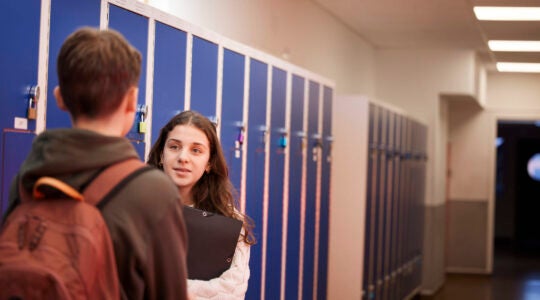“Hey, she’s stealing men’s mitzvot!”
This was my eight year old son’s reaction to seeing the photo (pictured below) of a woman raising the open Torah scroll for hagba’ah (JOFA Journal Fall 2013).
While he had certainly never seen a woman do hagba’ah before, I was taken aback by his set ideas of where Torah belonged. I expected that the photo would create dissonance for some Orthodox men and women, but did not expect it of a younger boy. This gave new perspective and urgency to my advocacy for greater inclusion of women in orthodox ritual life. In particular, it reinforced the importance of visual symbols in shaping our understanding, both those we see and those that are absent.
The following Simhat Torah they admitted that for the first time they looked beyond the mechitza and noted women’s lack of active participation in the celebration.
As the mother to four sons, I began a family discussion about the discrepancy between women’s open access to Torah study on one hand, and the more limited access to the physical Torah scroll on the other. The following Simhat Torah they admitted that for the first time they looked beyond the mechitza and noted women’s lack of active participation in the celebration.
As our community began offering women the opportunity to dance with the sefer Torah, I found that many of them were reluctant to take their turn holding the Torah. This held true for women of different ages, religious education and affiliation. Some admitted they weren’t comfortable, others made excuses.
Religious symbols are culturally and deeply embedded, and they can generate very strong feelings. We tend to associate the sefer Torah with holiness and reverence. The visual absence of women with a sefer Torah in Orthodox circles is one of the roots for feelings of discomfort if not outright withdrawal. These feelings are very powerful, as they in turn motivate us to generate logical arguments to support our initial reactions, and finally dictate our practice.
For those who have always danced with the Sefer Torah, this is an opportunity to consider who has not enjoyed that privilege, and how we can extend access and enable inclusion.
This year’s Simhat Torah celebrations will be different, presenting the opportunity to reflect on our assumptions. For those who have always danced with the Sefer Torah, this is an opportunity to consider who has not enjoyed that privilege, and how we can extend access and enable inclusion. For those of us who have never held a Sefer Torah, it may be a moment to contemplate what associations and feelings hold us back. And perhaps despite our feelings, commit to try something new. Action can also generate powerful feelings.
We often experience a surge of affection as we embrace another person. Could a joyful embracing of the Sefer Torah engender new love and commitment to a life filled with Torah?
Rabba Dina Brawer is mother to four sons, and is passionate about passing Torah to women and girls. She holds a BA in Hebrew and Jewish Studies from the University of London and an MA in Education and Psychology from the Institute of Education, London and Semikha from Yeshivat Maharat. She is the founder of JOFA UK , and the producer of #YourTorah podcast, a journey to discovering Mishnah. She currently serves as Director of Recruitment and Admissions for Yeshivat Maharat.
Posts are contributed by third parties. The opinions and facts in them are presented solely by the authors and JOFA assumes no responsibility for them.
If you’re interested in writing for JOFA’s blog contact dani@jofa.org. For more about JOFA like us on Facebook or visit our website.
The New York Jewish Week brings you the stories behind the headlines, keeping you connected to Jewish life in New York. Help sustain the reporting you trust by donating today.




